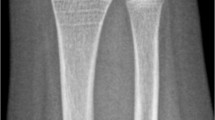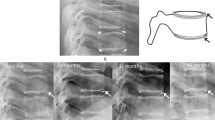Abstract
Background
Growth recovery lines, also known as growth arrest lines, are transverse radiodense metaphyseal bands that develop due to a temporary arrest of endochondral ossification caused by local or systemic insults.
Objective
To determine if growth recovery lines are more common in infants at high risk versus low risk for abuse.
Materials and methods
Reports of American College of Radiology compliant skeletal surveys (1999-2013) were reviewed with clinical records. Infants at low risk for abuse had a skull fracture without significant intracranial injury, history of a fall and clinical determination of low risk (child protection team/social work assessment). Infants at high risk had significant intracranial injury, retinal hemorrhages, other skeletal injuries and clinical determination of high risk. There were 52 low-risk infants (mean: 4.7 months, range: 0.4–12 months) and 21 high-risk infants (mean: 4.2 months, range: 0.8–9.1 months). Two blinded radiologists independently evaluated the skeletal survey radiographs of the knees/lower legs for the presence of at least one growth recovery line.
Results
When growth recovery lines are scored as probably present or definitely present, their prevalence in the low-risk group was 38% (standard deviation [SD] = 8%; reader 1 = 17/52, reader 2 = 23/52) vs. 71% (SD = 7%; reader 1 = 16/21, reader 2 = 14/21) in the high-risk group (P < 0.001; odds ratio 4.0, 95% CI: 1.7-9.5).
Conclusion
Growth recovery lines are encountered at a significantly higher rate in infants at high risk vs. low risk for abuse. This suggests that abused infants are prone to a temporary disturbance in endochondral ossification as a result of episodic physiological stresses.



Similar content being viewed by others
References
Park EA, Richter CP (1953) Transverse lines in bone: the mechanism of their development. Bull Johns Hopkins Hosp 93:234–248
Wegner G (1874) Ueber das normale und pathologische Wachsthum de Röhrenknochen. Eine kritische Untersuchung auf experimenteller und casiustischer Grundlage. Virchows Archiv Pathol Anat Physiol Klin Med 61:44–76
Gies T (1877) Experimentelle Untersuchungen über den Einfluss des Arsens auf den Organismus. Arch Exp Pathol Pharmakol 8:175–197
Harris H (1931) Lines of arrested growth in the long bones of diabetic children. Br Med J 1:713–714
Park EA (1964) The imprinting of nutritional disturbances on growing bones. Pediatrics 33:815–862
Mackie EJ, Ahmed YA, Tatarczuch L et al (2008) Endochondral ossification: how cartilage is converted to bone in the developing skeleton. Int J Biochem Cell Biol 40:46–62
Platt HS, Stewart JC, Platt BS (1963) Transverse trabeculae in the bones of malnourished children. Proc Nutr Soc 22:xxix–xxx
Dreizen S, Currie C, Gilley EJ et al (1956) Observations of the association between nutritive failure, skeletal maturation rate and radiopaque transverse lines in the distal end of the radius in children. Am J Roentgenol Radium Ther Nucl Med 76:482–487
Acheson RM (1959) Effects of starvation, septicaemia and chronic illness on the growth cartilage plate and metaphysis of the immature rat. J Anat 93:123–130
Alfonso-Durruty M (2011) Experimental assessment of nutrition and bone growth’s velocity effects on Harris lines formation. Am J Phys Anthropol 145:169–180
Park EA (1954) Bone growth in health and disease. Arch Dis Child 29:269–281
Follis R, Park E (1952) Some observations on bone growth, with particular respect to zones and transverse lines of increased density in the metaphysis. Am J Roentgenol Radium Ther Nucl Med 68:709–724
Ogden JA (1984) Growth slowdown and arrest lines. J Pediatr Orthop 4:409–415
Hummert JR, Van Gerven DP (1985) Observations on the formation and persistence of radiopaque transverse lines. Am J Phys Anthropol 66:297–306
Papageorgopoulou C, Suter SK, Rühli FJ et al (2011) Harris lines revisited: prevalence, comorbidities, and possible etiologies. Am J Hum Biol 23:381–391
Kleinman PK, Perez-Rossello JM, Newton AW et al (2011) Prevalence of the classic metaphyseal lesion in infants at low versus high risk for abuse. AJR Am J Roentgenol 197:1005–1008
American College of Radiology (2011) SPR-ACR practice parameters for skeletal surveys in children. In: Pediatric practice parameters & technical standards. American College of Radiology, Reston, VA
Garn S, Silverman F, Hertzog K et al (1968) Lines and bands of increased densitiy: their implication to growth and development. Med Radiogr Photogr 33:58–89
Gindhart PS (1969) The frequency of appearance of transverse lines in the tibia in relation to childhood illnesses. Am J Phys Anthropol 31:17–22
Mays S (1985) The relationship between Harris line formation and bone growth and development. J Archaeol Sci 12:207–220
Mays S (1995) The relationship between Harris lines and other aspects of skeletal development in adults and juveniles. J Archaeol Sci 22:511–520
Scott AB, Hoppa RD (2015) A re-evaluation of the impact of radiographic orientation on the identification and interpretation of Harris lines. Am J Phys Anthropol 156:141–147
Landis JR, Koch GG (1977) The measurement of observer agreement for categorical data. Biometrics 33:159–174
U.S. Department of Health and Human Services, Administration for Children and Families, Administration on Children, Youth and Families, Children’s Bureau (2015). Child maltreatment 2013. http://www.acf.hhs.gov/programs/cb/research-data-technology/statistics-research/child-maltreatment
Block RW, Krebs NF, American Academy of Pediatrics Committee on Child Abuse and Neglect, and American Academy of Pediatrics Committee on Nutrition (2005) Failure to thrive as a manifestation of child neglect. Pediatrics 116:1234--1237
Hernandez RJ, Poznanski AK, Hopwood NJ et al (1978) Incidence of growth lines in psychosocial dwarfs and idiopathic hypopituitarism. AJR Am J Roentgenol 131:477–479
Hynes D, O’Brien T (1988) Growth disturbance lines after injury of the distal tibial physis: their significance in prognosis. J Bone Joint Surg (Br) 70:231–233
Jaramillo D, Hoffer FA, Shapiro F et al (1990) MR imaging of fractures of the growth plate. AJR Am J Roentgenol 155:1261–1265
Ecklund K, Jaramillo D (2002) Patterns of premature physeal arrest: MR imaging of 111 children. AJR Am J Roentgenol 178:967–972
Kleinman P, Marks S, Blackbourne B (1986) The metaphyseal lesion in abused infants: a radiologic histopathologic study. AJR Am J Roentgenol 146:896–905
Tsai A, McDonald AG, Rosenberg AE et al (2014) High-resolution CT with histopathological correlates of the classic metaphyseal lesion of infant abuse. Pediatr Radiol 44:124–140
Kleinman PK, Marks SC Jr (1996) A regional approach to the classic metaphyseal lesion in abused infants: the proximal tibia. AJR Am J Roentgenol 166:421–426
Teele RL, Abbott GD, Mogridge N et al (1999) Femoral growth lines: bony birthmarks in infants. AJR Am J Roentgenol 173:719–722
MacChiarelli R, Bondioli L, Censi L et al (1994) Intra- and interobserver concordance in scoring Harris lines: a test on bone sections and radiographs. Am J Phys Anthropol 95:77–83
Suter S, Harders M, Papageorgopoulou C et al (2008) Technical note: standardized and semiautomated Harris lines detection. Am J Phys Anthropol 137:362–366
Author information
Authors and Affiliations
Corresponding author
Ethics declarations
Conflicts of interest
None
Rights and permissions
About this article
Cite this article
Zapala, M.A., Tsai, A. & Kleinman, P.K. Growth recovery lines are more common in infants at high vs. low risk for abuse. Pediatr Radiol 46, 1275–1281 (2016). https://doi.org/10.1007/s00247-016-3621-z
Received:
Revised:
Accepted:
Published:
Issue Date:
DOI: https://doi.org/10.1007/s00247-016-3621-z




